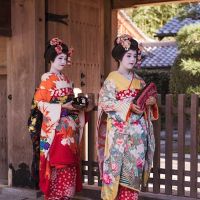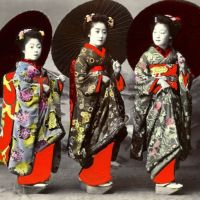The Journey to Becoming a Maiko: A Path of Tradition and Dedication
S-fleage
S-fleage is a Kyoto-based company. We are proud to introduce the charms of Kyoto to the world. We hope this article will help you to experience Kyoto.
Latest posts by S-fleage (see all)
Becoming a Maiko, an apprentice Geisha, is a journey that combines tradition, art, and a deep commitment to preserving Japanese culture.
This path requires dedication, patience, and a willingness to immerse oneself in the rich history and customs of the Hanamachi, or flower towns, where Geisha culture thrives.
Contents
History of Maiko
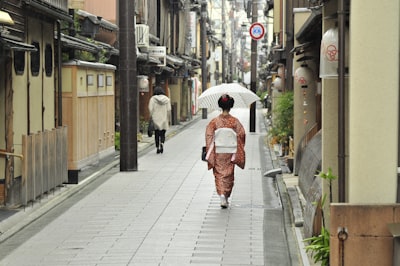
Maiko, or apprentice geisha, have been an iconic part of Kyoto’s cultural landscape for centuries.
Their origins can be traced back to the Edo period (1603-1868) when young girls began serving tea to travelers around Yasaka Shrine.
Initially, mizuchaya (tea houses) served only tea and dango (rice dumplings), but eventually, they began offering sake and food as well.
The young women working there started to perform shamisen music and dances, imitating Kabuki theater.
Today, maiko continue to train rigorously in traditional arts such as dance, music, and tea ceremony, preserving centuries-old customs while adapting to modern times.
The Initial Steps
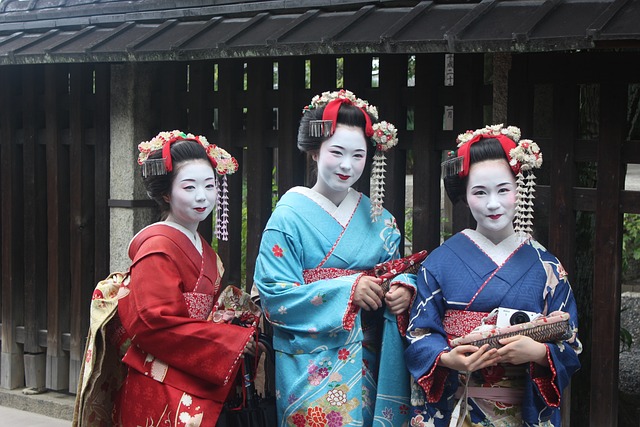
The journey to becoming a Maiko begins with a heartfelt decision to embrace the cultural legacy of the Geisha.
It requires a commitment to the arts and traditions of the Hanamachi, or flower towns, where this unique culture flourishes.
Prospective Maiko must find an Okiya, a Geisha house that will become their home and training ground.
The Okaa-san, or mother of the house, plays a pivotal role in guiding them through this journey, providing mentorship and support.
Decision to become a Maiko
The decision to become a Maiko is not taken lightly.
It often stems from a desire to embrace the cultural heritage of Japan and to master the traditional arts.
Many young girls, inspired by the grace and beauty of Geisha, choose this path with the hope of becoming part of an esteemed tradition.
Support from family is crucial, as the journey requires moving into an Okiya, or Geisha house, and dedicating several years to rigorous training.
Introduction to the world of Hanamachi (flower towns)
The Hanamachi are special districts in Kyoto where the Geisha culture is deeply rooted.
These “flower towns” are home to numerous tea houses and Okiya, where Maiko and Geiko (full-fledged Geisha) live and work.
The atmosphere in Hanamachi is steeped in history, with narrow streets and traditional wooden buildings that transport one back in time.
Entering this world means becoming part of a close-knit community that values tradition, discipline, and artistic excellence.
Finding an Okiya (geisha house) and the role of the Okaa-san (mother of the house)
The Okiya is where a Maiko lives during her training.
Finding the right Okiya is a crucial step, as it will become her home and support system.
The Okaa-san, or “mother of the house,” plays a vital role in the development of a Maiko.
She provides guidance, discipline, and care, ensuring that the young apprentice learns the necessary skills and upholds the standards of the Geisha tradition.
The Okaa-san is often a former Geisha herself and serves as a mentor, imparting wisdom and experience to the next generation.
https://en.wikipedia.org/wiki/Okiya
Shikomi: The First Stage
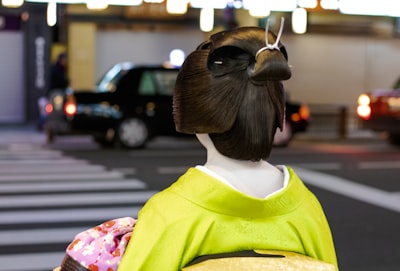
The first step toward becoming a Maiko (apprentice geisha) is called “Shikomi.”
This is a period of strict education and training to prepare for life in the hanamachi (flower town).
Nowadays, some okiya (geisha houses) offer a “Shikomi Experience” for about a week during school holidays.
Explanation of the Shikomi period (preparation stage)
The Shikomi period marks the beginning of a Maiko’s training.
This preparatory phase is crucial as it lays the foundation of skills and discipline needed for future success.
During this period, the trainees engage in daily chores and tasks within the okiya, learning basic skills and etiquette.
The many challenges they face at this stage prepare them for the demanding path ahead.
Daily chores and tasks
The trainee lives in the okiya, where there are also senior Geiko (fully-fledged geisha) and Maiko.
She assists the okiya’s mother and older sisters, and also practices dance.
These daily chores and tasks become a routine.
She also helps with household chores, learns how to care for kimonos, and assists in preparing for events.
She must wake up earlier than the senior Geiko and Maiko and stay up until the end of the evening’s engagements, often helping with tidying up costumes late into the night.
This stage focuses on building discipline and understanding the inner workings of a geisha’s life.
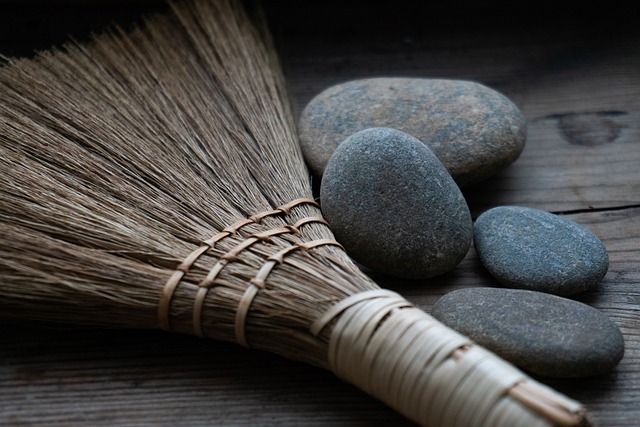
Learning basic skills and etiquette
In addition to chores, the Shikomi period involves learning the basic skills and etiquette essential for her future role.
She attends classes in dance, music, tea ceremony, and calligraphy, gradually developing the skills that will define her as a Maiko.
Proper manners and etiquette are emphasized, as they are crucial to the role of a geisha.
Among these, the Kyoto dialect (Kyokotoba) is particularly important, along with dance.
It is rigorously taught by the okiya’s mother and older sisters.
Recently, it has become challenging for both the learners and the teachers, as more trainees come from regions like Kanto, where accents and intonations differ.
Duration and challenges of the Shikomi period
The Shikomi period typically lasts about a year, though the duration can vary.
It is a challenging time, requiring perseverance and adaptability.
The transition from a typical lifestyle to the disciplined environment of an Okiya can be difficult, but it is an essential foundation for the stages that follow.
Minarai: The Second Stage
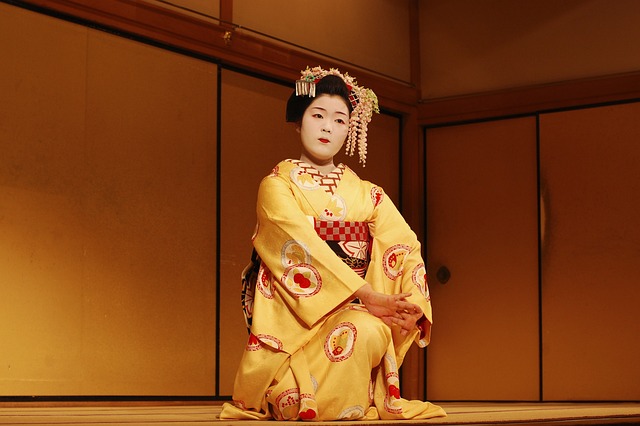
After about 10 months, if the dance master and other instructors approve, and the okiya’s mother determines that the trainee is suitable to become a Maiko based on her daily progress, she can pass to become an apprentice Maiko, known as “Minarai.”
Transitioning to the Minarai stage marks a shift from preparation to active learning.
As Minarai, they wear vibrant kimonos and accompany senior Maiko and Geiko to events, observing and imitating their skills.
This stage emphasizes learning through observation, allowing the apprentices to absorb the intricacies of the craft and refine their abilities in real-life situations.
Transition from Shikomi to Minarai (learning by observation)
The transition from Shikomi to Minarai is a crucial step in the journey of becoming a Maiko.
As a Minarai, the apprentice shifts from mere preparation to active learning through observation.
This stage provides direct experience in the work of a Maiko, allowing her to understand the subtleties of the profession.
Wearing the Minarai kimono
An essential aspect of becoming a Minarai is wearing the special Minarai kimono.
Unlike the modest attire of the Shikomi stage, the Minarai kimono is vivid and ornate, reflecting the progress of the apprentice.
This distinctive attire signifies her new status and role within the hanamachi.
Accompanying senior Maiko and Geiko to events and engagements
Minarai apprentices accompany senior Maiko and Geiko to various events and functions, observing their interactions and performances.
This exposure is invaluable, providing opportunities to learn the art of entertainment and the subtleties of social interactions firsthand.
The apprentice is guided by her older sister (senior Geiko with whom she has exchanged ceremonial cups of sake), ties her hair in the traditional “Ware-shinobu” style, and wears a half-length “darari” obi belt along with lower “Okobo” (wooden clogs) as she attends banquets, gradually learning the job on-site.
Focus on learning through observation and imitation
The primary focus of the Minarai stage is learning through observation and imitation.
By closely watching her seniors, the apprentice hones her skills, learning the art of conversation, dance, and music.
This stage emphasizes practical experience and prepares her for her eventual debut.
Maiko Debut: Misedashi
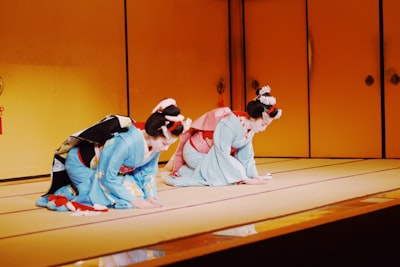
The Misedashi is a Maiko’s debut, marking her official entry into the world of Geisha.
This ceremony is significant, representing years of dedication and preparation.
Extensive preparations precede the debut, ensuring that the Maiko is ready for her first official appearance.
The event involves the community and family, celebrating the apprentice’s achievements and welcoming her into the esteemed ranks of Maiko.
The significance of the Misedashi (debut ceremony)
Once the Minarai has learned her duties at banquets, she finally makes her debut as a Maiko.
This debut is called “Misedashi.” For three days, she wears a formal black crested kimono and accompanies her senior Geiko to various banquets.
However, this is where the real training in the hanamachi begins.
In addition to dance, she now starts learning the shamisen (a traditional Japanese three-stringed instrument), Hayashi (traditional musical accompaniment including flute, drums, and small hand drums), singing (in styles such as Nagauta, Tokiwazu, and Kiyomoto), and the tea ceremony.
She aims to become a professional in both the performing arts and hospitality.
Preparations for the debut
Preparing for the Misedashi requires meticulous attention to detail.
The Maiko must be ready to represent both her okiya and the hanamachi.
This preparation involves refining her skills in dance, music, and conversation, as well as mastering the intricate process of wearing elaborate kimonos and applying traditional makeup.
On the day of Misedashi, her makeup is done for her, but after that, she will have to apply it herself.
For the first year as a Maiko, she applies red lipstick only to her lower lip.
After one year, she can apply lipstick to both lips.
First official appearance as a Maiko
The first official appearance as a Maiko is a highly anticipated event.
On the day of Misedashi, she wears a formal black crested kimono and visits tea houses and other establishments to introduce herself.
She is also introduced to the community and participates in ceremonies and performances.
This debut is both a celebration and a test of her readiness to embrace her new role.
Community and family involvement in the debut
The Misedashi is a community affair, with family, friends, and members of the Hanamachi coming together to support the new Maiko.
It is a time of celebration, with ceremonies, parties, and public appearances that honor the apprentice’s hard work and dedication.
The Early Steps: Training and Apprenticeship
Following her debut, the Maiko embarks on the early steps of her training and apprenticeship. This phase focuses on refining her skills and gaining experience in the art of entertainment. She continues to study and perform, gradually building her reputation and expertise. The journey to becoming a Geiko is ongoing, requiring continual learning and growth.


